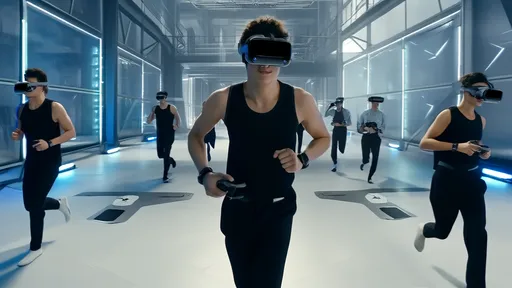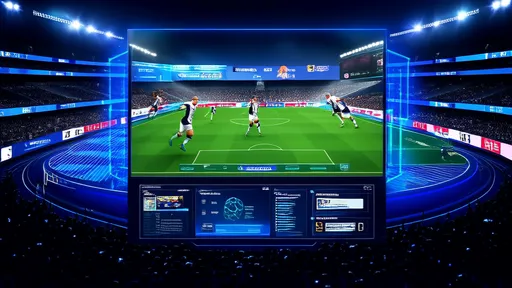The world of sports broadcasting is undergoing a quiet revolution, one that promises to transform how fans experience live events while creating unprecedented opportunities for advertisers. At the heart of this transformation lies augmented reality (AR) technology, which is enabling the real-time insertion of virtual advertisements into live sports coverage with startling realism.
The technology behind AR virtual ad insertion has matured significantly in recent years, moving from experimental implementations to mainstream adoption by major sports networks. Unlike traditional static signage or pre-recorded digital overlays, today's systems use advanced computer vision algorithms to track camera movements and player positions in real time. This allows virtual ads to maintain perfect perspective and positioning as cameras pan, zoom, or switch angles during live broadcasts.
What makes this development particularly exciting for broadcasters and advertisers alike is the level of personalization now possible. Different viewers watching the same live event can see entirely different virtual ads tailored to their demographics, location, or even purchase history. A soccer fan in Tokyo might see ads for a local electronics brand along the sidelines, while a viewer in London sees promotions for a British airline in the exact same spot.
The implications for sports leagues and rights holders are profound. Where physical stadiums once limited advertising opportunities to fixed signage locations, virtual ads can now appear anywhere in the camera's view - on playing surfaces, in mid-air above the action, or even integrated seamlessly into players' uniforms. This effectively creates an unlimited inventory of premium advertising space that can be sold multiple times over to different advertisers in different markets.
Technical challenges remain, particularly when it comes to maintaining the illusion of realism during fast-paced action. The latest generation of AR ad insertion systems employs machine learning to better understand the three-dimensional environment of the playing field and predict occlusions when players move in front of virtual signage. Lighting conditions, shadows, and reflections must all be accounted for to prevent the ads from appearing artificial or distracting.
Early adopters in sports like baseball and hockey have demonstrated the technology's potential. Virtual ads behind home plate or along the boards in hockey can change between innings or periods, or even between pitches in some implementations. The result is a dramatic increase in available ad inventory without cluttering the viewer's experience with excessive on-screen graphics.
Perhaps most intriguing is how this technology is enabling dynamic programmatic advertising in live sports for the first time. Just as digital ads on websites can be bought and served in real-time based on viewer data, virtual stadium ads can now be swapped programmatically during broadcasts. This allows for last-minute ad buys, regional targeting, and performance-based pricing models that were previously impossible in live TV sports advertising.
The business impact has been immediate and measurable. Early reporting from leagues and networks using the technology suggests virtual ad inventory commands premium pricing compared to traditional broadcast ads, while delivering higher recall rates among viewers. The ability to guarantee perfect product placement during key moments of gameplay - a beer logo appearing prominently during a championship celebration, for instance - provides advertisers with unprecedented contextual relevance.
Looking ahead, the next frontier for AR virtual advertising in sports may involve deeper integration with emerging viewing technologies. As more consumers adopt AR glasses and headsets, the line between broadcast ads and in-stadium signage could blur completely. Imagine attending a game where your personal AR device displays customized ads on the field while the spectator next to you sees entirely different promotions in the same physical space.
Regulatory and ethical considerations are beginning to emerge as the technology advances. Sports governing bodies face new questions about how virtual ads might affect game integrity or create unfair advantages. Should virtual ads be allowed to move or animate during play? How should leagues handle situations where virtual ads potentially distract players or officials? These discussions are just beginning as the technology outpaces existing frameworks.
For now, AR virtual ad insertion stands as one of the most significant developments in sports media since the introduction of instant replay. By creating a new layer of monetizable content that doesn't interfere with the actual competition, the technology offers a rare win-win scenario: enhanced revenue streams for rights holders and more relevant, targeted advertising for sponsors, all while maintaining (and in some cases enhancing) the viewing experience for fans.
The coming years will likely see this technology become standard across all major sports broadcasts, with the global market for virtual advertising in sports predicted to grow exponentially. As the systems become more sophisticated and viewer acceptance grows, we may reach a point where physical stadium signage becomes secondary to its virtual counterparts - invisible to home viewers but customized for maximum impact based on who's watching and where.

By /Jul 29, 2025

By /Jul 29, 2025

By /Jul 29, 2025

By /Jul 29, 2025

By /Jul 29, 2025

By /Jul 29, 2025

By /Jul 29, 2025

By /Jul 29, 2025

By /Jul 29, 2025

By /Jul 29, 2025

By /Jul 29, 2025

By /Jul 29, 2025

By /Jul 29, 2025

By /Jul 29, 2025

By /Jul 29, 2025

By /Jul 29, 2025

By /Jul 29, 2025

By /Jul 29, 2025